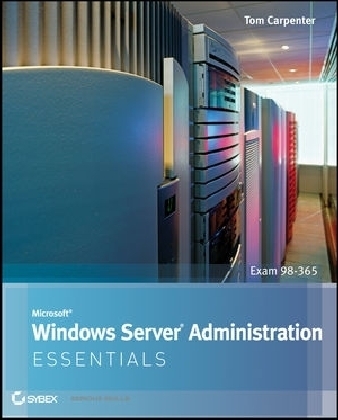
Microsoft Windows Server Administration Essentials
Sybex Inc.,U.S. (Verlag)
978-1-118-01686-2 (ISBN)
- Titel ist leider vergriffen;
keine Neuauflage - Artikel merken
The core concepts and technologies you need to administer a Windows Server OS Administering a Windows operating system (OS) can be a difficult topic to grasp, particularly if you are new to the field of IT. This full-color resource serves as an approachable introduction to understanding how to install a server, the various roles of a server, and how server performance and maintenance impacts a network.
With a special focus placed on the new Microsoft Technology Associate (MTA) certificate, the straightforward, easy-to-understand tone is ideal for anyone new to computer administration looking to enter the IT field. Each chapter offers a clear and concise look at the core Windows administration concepts you need to know to gain an understanding of these difficult topics.
Offers a clear, no-nonsense approach to administering a Windows operating system and presents it in such a way that IT beginners will confidently comprehend the subject matter
Targets the MTA 98-365 exam by covering Windows Server installation, server roles, storage, and active directory infrastructure
Provides you with a solid foundation of various networking topics so that you can gain a strong understanding of Windows Server administration concepts
Includes review questions and suggested labs to further enhance your learning process
With this book by your side, you will be armed with the core concepts and technologies needed to administer a Windows Server operating system.
Tom Carpenter is the author of several books for the IT industry, including Sybex's Microsoft SharePoint 2010 Administration: Real-World Skills for MCITP Certification and Beyond. He is the founder and senior consultant for The Systems Education Company (SysEdCo), a training and consulting company specializing in Microsoft and network infrastructure technologies. Tom has trained the U.S. Department of Defense, the FBI, Procter & Gamble, Wells Fargo, and several other companies and organizations on topics ranging from Windows Server administration to wireless LAN penetration testing.
Introduction xix Chapter 1 Windows Server Overview 1
Introducing Servers 1
Understanding Server Concepts 1
Understanding Client/Server Concepts 2
Choosing Server Hardware 6
Understanding Server Roles 8
Deploying Applications on Your Network 10
Providing Internet Access and Collaboration on Your Network 11
Managing Files and Printers on Your Network 12
Providing Network Access for Remote Users 12
Adding More Roles as Needed 13
Microsoft Windows Server Features 15
Windows Server User Interfaces 15
Networking Features 18
Management Features 19
Windows Server Editions 20
The Essentials and Beyond 22
Chapter 2 Installing Windows Servers 25
Installation Options 25
Choosing an Installation Destination 26
Performing an Interactive Installation 28
Automating an Installation 36
Understanding Windows Deployment Services 37
Upgrading Servers 38
Supported Upgrade Paths 38
Upgrades Versus Clean Installations 39
Understanding the Upgrade Process 40
Using Server Core 40
Server Core Features and Limitations 41
Performing a Server Core Installation 42
Administering a Server Core Installation 43
Working with Device Drivers 45
Understanding Device Drivers 45
Obtaining and Installing Drivers 46
Driver Maintenance 48
Understanding Hardware Resources 51
The Essentials and Beyond 54
Chapter 3 Managing Windows Server Storage 57
Data Storage Concepts 57
Selecting Hard Drives for Your Network 58
Choosing a File System 60
Understanding Networked Storage 61
Using the Distributed File System 62
Understanding RAID 64
Identifying Storage Technologies 67
Networked Storage Solutions 68
Understanding Disk Types 69
Basic and Dynamic Disks 69
Virtual Hard Disks 71
Optical Media 72
The Essentials and Beyond 72
Chapter 4 Administering Services 75
Understanding Services 75
Applications as Services 76
Important Windows Services 77
Add-On Services 81
Configuring Services 83
Service Startup Types 83
Service Recovery Options 84
Service Privileges 84
Managing Services 85
Starting Services 85
Stopping Services 86
Restarting Services 89
Troubleshooting Services 89
Service Dependencies 90
Service Configuration 91
Understanding Service Accounts 91
The Essentials and Beyond 92
Chapter 5 Active Directory Infrastructure 95
Understanding Active Directory 95
AD Domains 96
AD Domain Trees 99
AD Forests 100
Planning for Active Directory Servers 101
Domain Controllers 101
Supporting Servers 104
Planning a DNS Namespace 105
DNS Overview 105
Namespace Hierarchies 108
Exploring Sites and Replication 110
AD Sites 110
AD Replication 111
The Essentials and Beyond 113
Chapter 6 Configuring Active Directory 115
Planning an Active Directory Installation 115
High-Level Planning 116
Detailed Design 119
Installing Active Directory 123
Preparing to Install DNS 125
Adding the DNS Server Role 127
Configuring the DNS Zone 129
Configuring the IP Settings and Primary DNS Suffix 131
Installing the AD DS Role 135
Running the DCPROMO Wizard 136
The Essentials and Beyond 140
Chapter 7 Managing Active Directory 143
Exploring AD Management Tools 143
Understanding the AD Architecture Management Tools 144
Understanding the AD Object Management Tools 147
Working with Users and Groups 149
User Account Types 149
Creating User Accounts 151
Group Types and Scopes 155
Working with Groups 157
Group Management 162
Understanding Organizational Units and Containers 162
The Essentials and Beyond 164
Chapter 8 Group Policy Management 167
Understanding Group Policy 167
Group Policy Defined 168
Group Policy Requirements 170
Group Policy Management Tools 170
Group Policy Sections and Categories 172
Supporting Different Windows Client Versions 174
Defining the Group Policy Hierarchy 175
Group Policy Processing 175
Local Group Policy 177
Touring the Group Policy Management Console 179
Exploring the GPMC Interface 179
Understanding the GPMC Features 181
Creating a Group Policy Object 182
Determining Policy Settings 182
Creating the GPO 183
Linking GPOs to Containers 183
Modifying Permissions on the GPO 184
Configuring a Local Group Policy Setting 184
The Essentials and Beyond 185
Chapter 9 Application Servers 189
Understanding Application Servers 189
Database Servers 191
Microsoft SQL Server 192
Database Application Types 193
Mail Servers: Using Microsoft Exchange Server 195
Exchange Server Design Goals 197
Exchange Server Roles 198
Exchange Server Storage Architecture 198
Exchange Mailbox Management 199
Collaboration Servers 200
SharePoint 2010 Defined 200
SharePoint Editions 202
Monitoring Servers 203
Threat Management Servers 204
The Essentials and Beyond 205
Chapter 10 Internet Information Services ( I IS) 207
Understanding Web Services 207
Internet Information Services 209
Understanding How IIS Works 209
Adding the Web Server (IIS) Role 211
Configuring IIS 213
Running an FTP Server 217
Configuring Sites and Ports 221
Web Server Security 223
Planning for Authentication 223
Planning for Encryption 226
The Essentials and Beyond 229
Chapter 11 File and Print Servers 231
Exploring File Servers 231
Understanding Share Permissions 232
Understanding NTFS Permissions 234
Auditing Files and Folders 236
Understanding DFS 238
Understanding How DFS Works 238
Planning for DFS Recommended Uses 240
Creating a DFS Namespace 241
Understanding Print Servers 242
Managing Basic Print Server Functionality 242
Understanding Printer Pools 244
Using Web Printing 246
The Essentials and Beyond 247
Chapter 12 Remote Access Technologies 249
Planning for Remote Administration Tools 249
Understanding Remote Access Solutions 250
Virtual Private Networks (VPNs) 252
Understanding Remote Desktop Services 255
Remote Desktop Versus Remote Desktop Services 255
RDS Licensing 258
Remote Desktop Role Services 259
The Essentials and Beyond 260
Chapter 13 Server Troubleshooting 263
Introducing Troubleshooting Processes and Procedures . 263
REACTing 264
Research 266
Engage 267
Adjust 268
Configure 268
Take Note 269
Stepping Through the OSI Model 269
Layer 1 270
Layer 2 271
Layer 3 271
Upper Layers 274
Troubleshooting with the Hardware/Software Model 274
Hardware Problems 274
Software Problems 275
Symptom, Diagnosis, and Solution 276
Systems Thinking 277
Troubleshooting Tools 279
Task Manager 279
Performance Monitor 281
Resource Monitor 282
Event Viewer 284
The Essentials and Beyond 288
Chapter 14 Performance Tuning 291
Performance Myths and Truths 291
One System Component Is Seldom the Culprit 292
Better Code Is Better, But Better Design Is Best 293
It Still Has to Travel the Network 293
Command Prompt Tools 293
Using the TaskList Command 294
Using the SC Command 295
Using the TaskKill Command 296
Using the Shutdown Command 296
Using the SystemInfo Command 297
Using the TypePerf Command 299
Resource Monitor 300
Performance Monitor 302
Understanding Performance Counters 304
Defining a Baseline 306
Developing Monitoring Points 307
Viewing Live Performance Data 308
Capturing and Logging Performance Data 310
Viewing DCS Reports 312
Virtualization and Performance 313
Exploring Virtualization Modes 314
Understanding Microsoft Virtualization Solutions 316
Migrating Between Physical and Virtual 318
The Essentials and Beyond 319
Chapter 15 Server Maintenance 321
Maintaining the Hardware 321
Planning for Server Downtime 325
Executing the Planning Actions for Downtime . 325
Understanding the Windows Server Boot Process 326
Understanding Windows Update 328
Updating with Windows Update 330
Using Windows Server Update Service 333
Automating with Logs and Alerts 338
Planning for Continuity 339
Disaster Recovery 340
Clustering 344
The Essentials and Beyond 345
Appendix A Answers to Review Questions 349
Chapter 1 349
Chapter 2 350
Chapter 3 350
Chapter 4 351
Chapter 5 352
Chapter 6 353
Chapter 7 353
Chapter 8 354
Chapter 9 355
Chapter 10 356
Chapter 11 357
Chapter 12 357
Chapter 13 358
Chapter 14 359
Chapter 15 360
Appendix B Microsof t’s Certification Program 361
Certification Objectives Map 362
Index 367
| Verlagsort | New York |
|---|---|
| Sprache | englisch |
| Maße | 185 x 234 mm |
| Gewicht | 816 g |
| Themenwelt | Informatik ► Betriebssysteme / Server ► Windows |
| Informatik ► Betriebssysteme / Server ► Windows Server | |
| Mathematik / Informatik ► Informatik ► Netzwerke | |
| ISBN-10 | 1-118-01686-6 / 1118016866 |
| ISBN-13 | 978-1-118-01686-2 / 9781118016862 |
| Zustand | Neuware |
| Haben Sie eine Frage zum Produkt? |
aus dem Bereich


